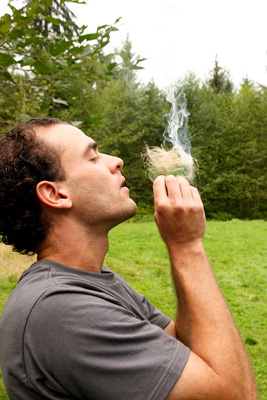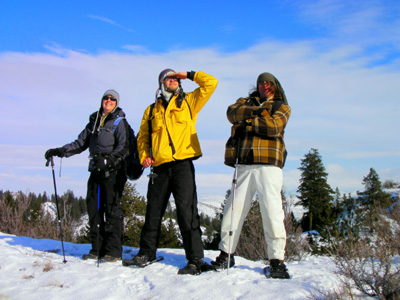Wilderness Survival Quiz

A wilderness survival quiz can be a fun way to learn more!
These questions cover a wide variety of wilderness survival skills, including knowledge of making shelter and fire, finding survival food, recognizing hazards and addressing first-aid situations.
Going through a wilderness survival quiz like this can help you learn new information as well as refresh your memory of survival essentials. It can be fun to quiz yourself or your friends on what you know. Once you have finished this quiz, you can view the answers at the bottom.
1. Which of these factors do not contribute to the drying of wood (for the purpose of finding dry parts of a bow-drill fire-making kit)?
A. Being on the south side of trees
B. Branches being exposed to sun and wind
C. Branches high up in a tree
D. Branches being covered in moss
2. Where would you find dry tinder in the rain?
A. Inner bark on cedar trees
B. Under rocks covered in lichen
C. Under moss
D. Ocean spray flower heads
3. What do you need to do to a coal to make it ignite a wet tinder bundle?
4. What are three edible plants available during the fall season?
5. Where would you find a vitamin D supplement in nature?
6. Which of the following is not a sign of hypothermia?
A. Shivering
B. Apathy and lethargy
C. Incoherence, irrational behavior
D. Impairment of muscular performance
E. Stomach pains
7. What should you do if attacked by a cougar?
A. Play dead
B. Fight back
C. Take a picture
D. Talk calmly and try to sneak away
8. What percentage of blood loss will likely cause death?
A. 10%
B. 15%
C. 25%
D. 50%
9. Your friend fell out of a tree trying to get honey from a bee hive. She fell 20 feet and was knocked unconscious for 45 seconds. You know from your training that she should be monitored for 24 hours. Which of the following signs do NOT indicate a serious head injury?
A. Complaints of blurred vision lasting over an hour
B. Unusual tiredness or sleepiness
C. A headache that increases in intensity
D. Burps that smell like sulfur
E. Unusual loss of balance
10. Your other friend went up into the honey tree and also fell. He was knocked unconscious for 5 minutes. Which of the following is NOT a sign of serious head trauma with a need for rapid evacuation?
A. Depressed fracture of the skull
B. Black and blue around swollen eyes
C. Black and blue behind and below the ears
D. Unusual rigid postures
E. Shivering uncontrollably.
11. Why must you apply a traction device for a broken femur? (A traction device gently creates tension to pull the foot away from the body).
A. To prevent movement of the broken leg
B. Reduce bleeding into the thigh
C. Reduce the amount of pain
D. To prevent further injury by spasms of the muscles
E. All of the above
12. Which is more dangerous, emotional shock or true shock?
13. What is the cause of true shock?
14. What is the most consistent sign of true shock?
A. Rapid, weak pulse
B. Rapid breathing
C. Pale or bluish skin, nail beds, and lips
D. Restlessness, anxiety, weakness
E. Nausea and vomiting
15. When digging for water at a curve in a dry river bed, is it better to dig on the inside of the curve or the outside of the curve?
16. What are three edible/nutritional uses of pine trees?
17. What are three natural bow drill cord possibilities local to the northwest?
18. What is the most important calorie source in survival living?
A. Sugar
B. Fat
C. Carbohydrates
D. Protein
19. Which method of cooking wild food will retain the most nutrients?
A. Boiling in a pot
B. Roasting on the coals
C. Pit baking
D. Frying on a rock
20. Which of these animals is the most dangerous when in western Washington?
A. Rattlesnakes
B. A wounded deer
C. Black bears
D. Mountain Lions
E. Wolves
21. Which of these is the most useful stone tool for survival living?
A. A big sandstone slab
B. An obsidian dagger
C. A burin
D. A baseball sized granite cobble
22. When making a bow-drill cord from natural fibers like dogbane or nettle, what is the best number of strands to reverse-wrap?
A. 1
B. 2
C. 3
D. 9
23. Where is the best place to go to look for rocks in a survival situation?
A. North facing slopes
B. South facing slopes
C. River beds
D. Mountain tops
E. Cedar forests
24. What is a good number of traps to set in a survival situation?
A. 1-3
B. 3-5
C. 10-20
D. 143
25. What is the most important thing in a survival situation?
A. Practice and preparation
B. Positive attitude
C. Big muscles
D. Always carrying a knife

Answers: Here are the answers to this wilderness survival quiz.
1. D. Moss often grows on wet, rotten wood.
2. A.
3. If a tinder bundle is wet then the coal needs to be extra large to dry out the bundle before it has burned out. This can be accomplished with coal extenders like cattail fluff or wood dust. Coal extenders must be dry.
4. In the fall, nutrients are stored in the roots of biennials and perennials. It is also the time of mast producers. Cattail roots, bitterroot, burdock root, lily species (yellow-bells, glacier lily), acorns (in most of the country), pine nuts, hazel nuts, and many others.
5. Certain mushroom species are high in vitamin D such as chanterelle. This is important when there is such little sunlight like in the winter in western Washington.
6. E.
7. B.
8. D.
9. D. Burps that smell like sulfur is a sign of giardia.
10. E.
11. E.
12. True shock.
13. The inability of the body to supply adequate amounts of blood to the vital organs. Generally caused by rapid blood loss.
14. A. Rapid weak pulse is the most consistent sign of shock. When blood volume is reduced, the heart speeds up, trying to compensate by circulating the blood more rapidly. Blood pressure falls causing faint pulse. In early shock the pulse rate may be normal when the victim is lying down, but speeds up when the person sits or stands.
15. The outside of the curve will be deeper and hold more water.
16. Inner bark for food, pine nuts for food, pine needles for tea rich in vitamin C.
17.
Conifer rootlets, inner cedar bark, inner maple
bark, scot's broom bark
18. B.
19. A.
20. B.
21. A. Sandstone slabs are extremely useful for shaping wood, cracking nuts, grinding seeds, sharpening bone and antler and many other tasks.
22. C. 3 strands are less bumpy which works well for bow-drill.
23. C
24. C.
25. A.
Thank you for taking our wilderness survival quiz! We hope it was fun and insightful. Taking this wilderness survival quiz again every once in a while will help you remember important details. Also remember, nothing beats hands-on practice and experience in the field when it comes to wilderness survival.
By the way, if you enjoyed this article then you'll love our survival mini guide. You'll discover six key strategies to staying alive in the outdoors plus often-overlooked survival tips. We're currently giving away free copies here.
Resources
Take your knowledge far beyond this wilderness survival quiz - Check out our Wilderness Survival Courses.
For more Wilderness Survival articles check out SurvivalLife.com

About the Author: Connor O'Malley is an experienced wilderness skills educator. He taught at Alderleaf for several years. Learn more about Connor O'Malley.
Return from Wilderness Survival Quiz to Wilderness Survival Articles
Is The Essential Wilderness Survival Skills Course Right for You? Take the "Online Survival Training Readiness" Quiz
See for yourself if this eye-opening course is a good fit for you. It takes just a few minutes! Get your Survival Training Readiness Score Now!

Grow Your Outdoor Skills! Get monthly updates on new wilderness skills, upcoming courses, and special opportunities. Join the free Alderleaf eNews and as a welcome gift you'll get a copy of our Mini Survival Guide.

 The Six Keys to Survival: Get a free copy of our survival mini-guide and monthly tips!
The Six Keys to Survival: Get a free copy of our survival mini-guide and monthly tips!
Learn more